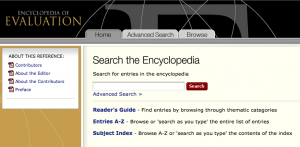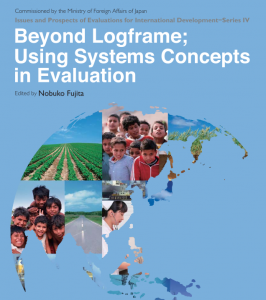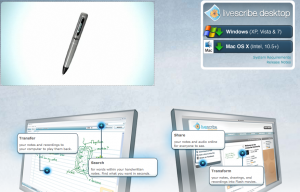A nice resource (Using Systems Concepts in Evaluation) to help understand how systems concepts and thinking are relevant for evaluation. Especially nice is the more nuanced discussion of logic models and how they help and hinder quality evaluation practice.
Encyclopedia of Evaluation online
Sage Publications has launched Sage Reference Online. After exhausting the print copy sales to libraries, Sage has bundled most of its Encyclopedias and Handbooks and sold online access to these same libraries. The good news is that many more people at an institution will have access to the information. The Encyclopedia of Evaluation is included in this package, so if you are at a University or College that subscribes to Sage Reference Online you will have free access to this resource, and many more.

Evaluation as covert operation… GAO goes all Jack Bauer!
 One of the things I like about evaluators is the ingenuity they demonstrate in finding ways to answer evaluation questions. The recently released GAO evaluation of the Energy Star program is delicious… and subversive. How else to evaluate the Energy Start Program than to submit bogus products for review and see what happens? That’s what the GAO did and the results are funny, and not so funny. In just eleven days the GAO received an energy star approval for their “room air cleaner” (see pic). Also approved were the gasoline-powered alarm clock, metal roof panel, and light commercial HVAC. Take away message: the Energy Star program is a cheap and easy seal of approval that probably means nothing in many cases… think twice before paying extra for that Energy Star seal!
One of the things I like about evaluators is the ingenuity they demonstrate in finding ways to answer evaluation questions. The recently released GAO evaluation of the Energy Star program is delicious… and subversive. How else to evaluate the Energy Start Program than to submit bogus products for review and see what happens? That’s what the GAO did and the results are funny, and not so funny. In just eleven days the GAO received an energy star approval for their “room air cleaner” (see pic). Also approved were the gasoline-powered alarm clock, metal roof panel, and light commercial HVAC. Take away message: the Energy Star program is a cheap and easy seal of approval that probably means nothing in many cases… think twice before paying extra for that Energy Star seal!
Cool tool for cool evaluators: Smartpen
New blog ~ Genuine Evaluation
Genuine Evaluation is a blog where Patricia Rogers and Jane Davidson share their ideas about real, genuine, authentic, practical evaluation – what it looks like, good examples, bad examples, lessons learned, tips, useful practices and methodologies.
New journal: CRITICAL EDUCATION
The Editorial Team of Critical Education is pleased to launch the inaugural issue of the journal. Click on the current issue link at the top of the home page to read “The Idiocy of Policy: The Anti-Democratic Curriculum of High-stakes Testing” by Wayne Au. Au is assistant professor of education at Cal State University, Fullerton and author of Unequal By Design: High-Stakes Testing and the Standardization of Inequality (Routledge, 2009).
To receive notification of new content in Critical Education, sign up as a journal user (reader, reviewer, or author).
Look for the initial installments of the special section edited by Abraham DeLeon titled “The Lure of the Animal: Addressing Nonhuman Animals in Educational Theory and Research” in the coming weeks.
Social Network Analysis ~ how to
Social network analysis (SNA) is a tool that may be useful in an evaluation if there are questions about the effectiveness of networks or the ways in which networks contribute to distributing or sustaining knowledge.
Durland & Fredericks are co-editors of an issue of New Directions for Evaluation that addresses the application of SNA to evaluation. The issue is described:
The application of SNA is relatively new for mainstream evaluation, and like most other innovations, it has yet to be fully explored in this field. The volume aims to fill the gaps within SNA methodology exploration by first reviewing the foundations and development of network analysis within the social sciences and the field of evaluation. The focus then turns to the methodology. Who holds power in a network, and what measures indicate whether that power is direct or indirect? Which subgroups have formed, and where are they positioned in an organization? How divided is an organization? Who forms the core of a collaboration, and where are the experts in an organization? These are the types of common questions explored in the four case studies of the use of network analysis within an evaluative framework. These cases are diverse in their evaluation situations and in the application of measures, providing a basis to model common applications of network analysis within the field. The final chapters include a personal account of current use by a government agency and suggestions for the future use of SNA for evaluation practice.
Additionally, the following online text is freely available as a reference.
Hanneman, Robert A. and Mark Riddle. 2005. Introduction to social network methods.
A Practical Guide for Engaging Stakeholders in Developing Evaluation Questions
This guide provides the reader with a five-step process for involving stakeholders in developing evaluation questions, and includes a set of four worksheets to facilitate this process. Good resource written by Hallie Preskill.
Download the Engaging Stakeholders Guide.
Evaluation of advocacy
The Harvard Family Research Project offers a number of publications and dialogues on evaluation potentially valuable across many evaluation contexts. A new publication on evaluating advocacy efforts has just been released. This suggests a shift in the focus of evaluation ~ in addition to programs, personnel, and products ~ to also include strategy, planning and action.
Organizational assessment
A website with resources for organizational evaluation, with a focus on assessment, learning and change is Reflect & Learn, a joint venture between International Development Research Centre (IDRC) and Universalia Management Group. In their words, the purpose of the website is:
Also we believe that improving organizations requires constant work. We are convinced that there is no “silver bullet” for improving the performance of organizations. Thus organizations need to learn about themselves and develop the problem solving skills to transform learning and insight into action. To do this an important step is for organizations to be able to generate systematic and credible evidence about themselves; who they are, how they function, and how well they are performing. The organizational assessment frameworks and approaches presented in this web site is our attempt to help organizations better knows themselves.

 Follow
Follow

